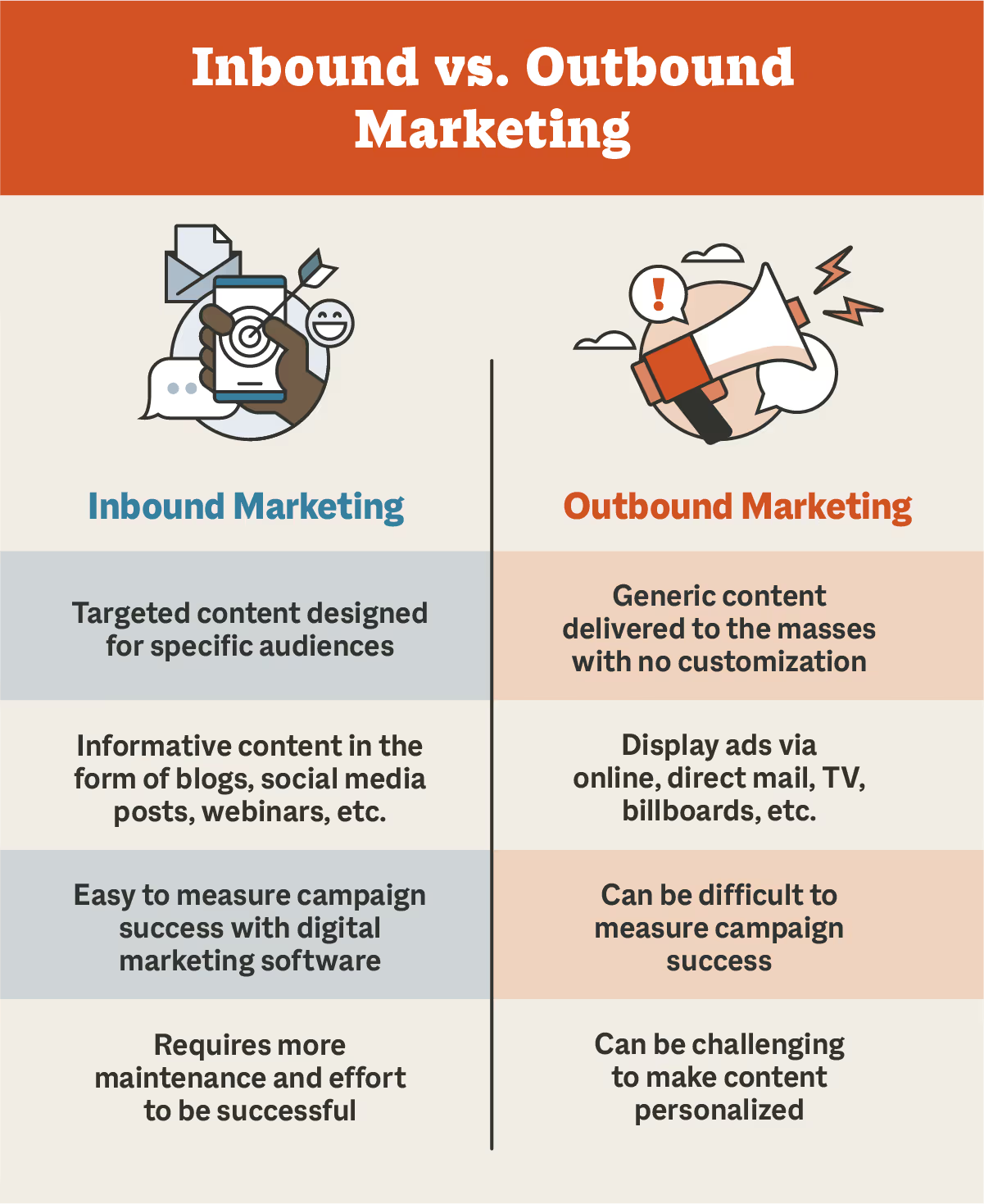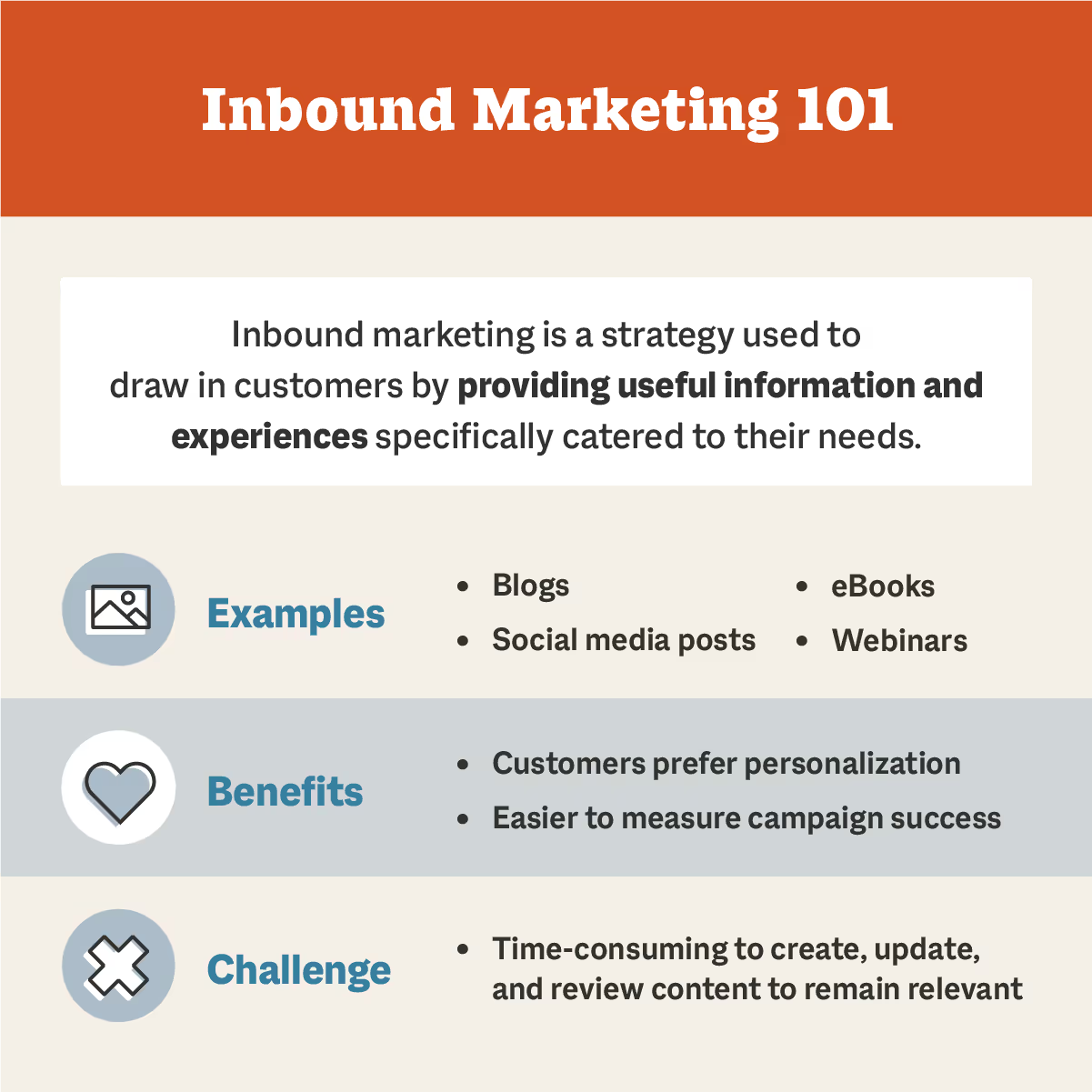The Differences Between Inbound vs. Outbound Marketing
The Differences Between Inbound vs. Outbound Marketing

Marketing is a critical part of every business strategy. Of course, the marketing umbrella itself also includes several different areas of focus that will need their own strategies to create a dynamic, robust total marketing solution for your business.
Understanding the differences between inbound vs. outbound marketing isn’t only relevant to your marketing team - but sales too. Just because they’re in the trenches selling doesn’t mean they shouldn’t understand the marketing strategy that is responsible for bringing sales leads their way.
In this article, you’ll get a chance to look at inbound vs. outbound marketing, along with examples and the benefits and challenges of each, so that you can get the facts and figure out how to use these strategies to help grow your business.

Inbound vs. outbound marketing
There are two main types of marketing that every company will have to consider: inbound and outbound marketing. Each has its own pros and cons, as well as its place in your business strategy.
For example, you might reach out to customers with outbound marketing as part of a campaign, but you might choose to take the inbound route during the holidays by offering a special deal for those who contact you and request it.
At their core, the terms “inbound” and “outbound” are fairly self-explanatory.
Inbound marketing is more about creating and distributing material that attracts people to your brand, website, or business. It’s typically considered the “pull” method.
On the other hand, outbound marketing involves proactive efforts to reach directly out to prospects to capture their interest or attention. It’s often considered the “push” method.
Both strategies are required for a successful marketing program, and there’s a lot more to understand once you pull back the curtain.
What is inbound marketing?
Inbound marketing is a business strategy companies use to draw in customers by providing useful information and experiences specifically catered to their needs. It’s a way of attracting business that is becoming much easier and more accessible, thanks largely to the Internet.
In several instances, inbound marketing is far more effective than outbound marketing because it allows you to customize content and deliver a personalized experience that can draw a buyer to you and sway their purchasing decision.
And it isn’t just about personalization. It involves producing content that potential customers would locate on their own, either for entertainment or educational purposes.

Inbound marketing examples
A holistic strategy that uses omnichannel marketing is the key to success with inbound marketing. This means that you’ll want to create content for various channels like your website and social media platforms.
Some examples of inbound marketing include:
- A blog
- eBooks
- Case studies
- Social media posts
- YouTube videos
- Webinars
- Podcasts
- A white paper
- SEO (search engine optimization)
You should use SEO (search engine optimization) techniques to broaden your reach with these examples, such as your blog and social media posts.
Digital tools are a big part of modern marketing efforts and they will help you get more out of your own inbound campaigns when you are getting started. Make sure to consider what marketing tools you’re using (and what their functions are) to help get the job done.
Benefits of inbound marketing
As far as benefits go, there’s plenty to go around with inbound marketing.
Consumers prefer it: Consumers like inbound marketing because it’s less abrasive and pushy. They appreciate the personalization when they do stumble across targeted ads to products they can use, too. In fact, 88% of marketers reported measurable gains from utilizing personalization.
Reach a wider audience: You can use inbound marketing to create a dynamic marketing strategy that draws in audiences of all types from all platforms.
Easier to measure: Inbound marketing is easily quantifiable, which means you can measure your success (or find strategies that need a little tweaking) as you go. You don’t have to rely on crossing your fingers in hopes that things will get better.
Inbound marketing KPIs
Your best gauge of performance comes from inbound marketing key performance indicators (KPIs). They provide data on the effectiveness of your inbound marketing efforts as well as the outcomes they are generating. They can also point out areas of your marketing plan where improvements are needed.
Some KPIs for inbound marketing include:
- Organic traffic: Shows you how much organic traffic your content and website are getting.
- Social media traffic: Shows you how much organic traffic your social media channels are getting.
- Time-on-site: Tells you how much engagement your content is getting.
- Time-on-page: Shows you how long a site visitor spends on a particular page of your website.
- Bounce rate: Shows you what percentage of people make it to a page on your site and bounce right off, or immediately navigate away.
- Conversion rate: Shows you how many people are taking a desired action on your content or website (e.g. downloading an eBook).
- Lifetime value of a customer: Tells you how much you earn from a customer over the term of their engagement with you.
- Return on investment (ROI): Tells you how much you're making, compared to how much you're spending on your inbound marketing campaign.
Challenges of inbound marketing
Inbound marketing is educational and creates ongoing success. The only real challenge with this type of marketing is that it typically requires more maintenance and effort than outbound marketing.
While you may need to spend more time creating, reviewing and updating content, doing so will give you a chance to reconsider your material and make sure that your brand maintains a consistent image. For all the effort you put in, you can get an impressive list of returns.
What is outbound marketing?
Outbound marketing is a strategy where a business sends non-targeted messaging out to a wide audience, hoping to attract new buyers or customers. It’s like throwing a net in the lake and hoping to catch at least a handful of fish in the process.
Instead of casting a targeted line, like with inbound marketing, most outbound marketing efforts are catered to the masses.

Outbound marketing examples
With outbound marketing, the content and messaging your business puts out can be relevant for an entire market - but can’t be personalized to just one potential customer. Companies therefore typically target their messaging to the mass public and make it more general.
Some examples of outbound marketing include:
- Billboards
- Newspaper ads
- Google ads
- Direct mail
- Event sponsorships
- Trade show presentations
- TV/radio advertising
Cold calling and emailing are also examples of outbound marketing. However, these tactics can sometimes utilize personalization, unlike billboards, radio or television advertisements. For instance, you can personalize a cold email by incorporating a prospect’s name and job title, thanks to marketing automation. For this reason, cold calling and email are oftentimes seen as complementary to inbound programs (even though, by nature, they can be viewed as outbound).
Benefits of outbound marketing
There are several perks to be had from outbound marketing, even though it’s less directional than inbound marketing.
Helps promote brand awareness: Outbound marketing gives you the chance to encounter people who may not have heard of your company before.
Get faster impressions: If executed right, you could potentially get instant views and impressions on your content.
More customer engagement: If your material is compelling enough, such as data studies or interactive quizzes, you can engage more customers even if it isn't strictly personalized.
Outbound marketing KPIs
Although outbound marketing is more difficult to track than inbound marketing, you may still track some KPIs for specific outbound initiatives.
While it can be challenging to monitor TV ads and billboards, outbound marketing efforts like online ads, emails, and phone calls are simple to track.
Some key performance indicators (KPIs) for outbound marketing include:
- Customer acquisition cost (CAC): Measures of how much it costs to acquire a new customer and if the investment is actually worth it (Think: is your thousand-dollar ad campaign bringing in enough leads to make it worth the investment?)
- Conversion rate: Shows you how many people are taking a desired action on your ads (e.g. calling your business from a landing page after clicking on a Google ad).
- Email open/response rates: Shows you how many leads are opening and responding to your emails.
- Phone call connect rate: Tells you the ratio between the number of calls made and the number of answers received (including voicemails) within a certain time frame.
- Return on investment (ROI): Tells you how much you're making, compared to how much you're spending on your outbound marketing campaign.
Challenges of outbound marketing
Compared to inbound marketing, outbound marketing presents additional challenges because it might be more difficult to make your messaging interesting and relevant due to its broad nature. Consumers are also well-versed in tuning out many types of outbound marketing.
The other big drawback here is that it can be difficult to measure the effectiveness of some of the outbound campaigns that you create. For example, it can be challenging to determine how many people actually heard a radio ad or whether it successfully reached the intended audience.
They can also be quite costly. Therefore, while this should be part of your strategy, you’ll need to decide how much you can really afford to spend and whether inbound marketing might be the better choice.
Although outbound marketing has its share of challenges, there is always a need for it. Both inbound and outbound strategies are important for businesses to reach their intended target audience and generate leads.
Let Smith.ai handle your marketing efforts
Inbound vs. outbound marketing, it doesn’t matter — it all takes time. And that’s valuable time that you could be spending on warm leads, existing customers, and prospects that are already further in the buying journey than those with whom you’re making first contact.
Instead, you can rely on the dedicated agents at Smith.ai for handling all of your inbound and outbound calling needs.
Along with our virtual receptionist service (like after-hours call answering and live website chat support), we can help manage your inbound and outbound calls and handle all kinds of outreach needs for your business. Plus, we’ll help you create a strategy to keep it organized and measured, too.
To learn more, schedule a consultation to discuss what the virtual receptionists at Smith.ai can do to help your marketing and more. You will also find us at hello@smith.ai or (650) 709-2710.
Take the faster path to growth. Get Smith.ai today.
Key Areas to Explore
Technical Implementation Terms
Voice user interface (VUl) design
Speech recognition integration
Text-to-speech optimization
API connectivity and webhooks
Real-time data synchronization

Your submission has been received!














.svg)



